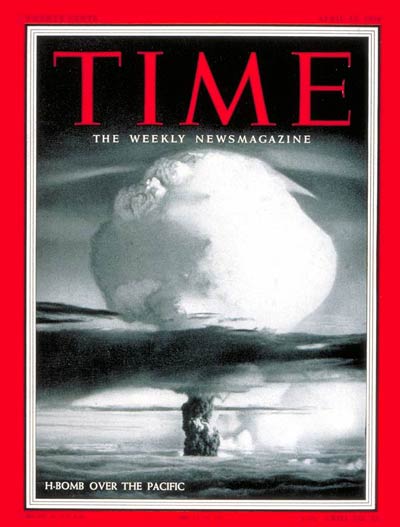
On Nov. 1, 1952—63 years ago this week—the U.S. detonated the first hydrogen bomb, resulting in the first successful full-scale thermonuclear weapon explosion.
Operation Ivy was conducted on the Eniwetok Atoll in the Marshall Islands. It involved two test bombs, one (“Mike”) a fusion device and the other a “stockpile” fission device. An experimental hydrogen bomb weighing an immense 82 tons, Mike was not a deliverable weapon—but it was noteworthy as the first nuclear bomb to get a significant portion of its explosive energy from fusion, or the joining of atoms, instead of only from fission, the splitting of atoms. In order to work, it relied on a fission explosion that would trigger fusion in liquid deuterium, a heavy hydrogen isotope.
At 7:15 a.m. local time on Elugelab Island, Mike was detonated from a control ship 30 m. away. The detonation resulted in a massive explosion, equivalent to 10.4 Megatons of TNT. As a military report on the history of Operation Ivy noted, “The Shot, as witnessed aboard the various vessels at sea, is not easily described. Accompanied by a brilliant light, the heat wave was felt immediately at distances of thirty to thirty-five miles. The tremendous fireball, appearing on the horizon like the sun when half-risen, quickly expanded after a momentary hover time.”
In a cover story after the test was confirmed to the public, TIME described its effects: “the force and horror of atomic weapons had entered a new dimension…the first full-dress H-blast (Operation Ivy) had turned the mid-Pacific sandspit named Elugelab into a submarine crater.”
The fireball reached about 3.25 m. in diameter. Elugelab, the island on which Mike’s detonation took place, was indeed vaporized, leaving a crater 6,300 ft. in diameter and 160 ft. deep. The mushroom cloud was 100 m. wide at its greatest extent. A sailor who witnessed the blast, however, didn’t think that “mushroom” was the foodstuff most applicable: “The cloud itself was kind of rough,” a sailor wrote, “yet it looked smooth — something like a cauliflower.”
At that point in 1952 it was the largest nuclear explosion ever. Today it still ranks fourth largest among all U.S. nuclear tests.
News of the test leaked immediately, but went unconfirmed. A TIME reporter called the Atomic Energy Commission and a LIFE reporter called the Department of Defense, both requesting confirmation of an H-bomb less than three hours after the test—both reporters gave the correct time of detonation, which was highly secret information—but nonetheless news of Ivy Mike was not publicly acknowledged until April 1, 1954, when a 28-minute television film was released to the public.
Read more about Operation Ivy Mike, here in the TIME Vault: The Road Beyond Elugelab
More Must-Reads from TIME
- How the Economy is Doing in the Swing States
- Democrats Believe This Might Be An Abortion Election
- Our Guide to Voting in the 2024 Election
- Mel Robbins Will Make You Do It
- Why Vinegar Is So Good for You
- You Don’t Have to Dread the End of Daylight Saving
- The 20 Best Halloween TV Episodes of All Time
- Meet TIME's Newest Class of Next Generation Leaders
Contact us at letters@time.com